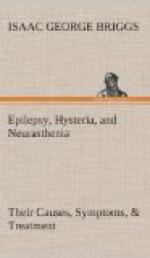Nearly every drug in the Pharmacopoeia has been tried, the drugs now generally used being sodium, potassium and ammonium bromide.
Before bromides were introduced by Locock in 1857, very strict hygienic, dietic and personal disciplinary treatment combined with the use of drugs often effected improvement. Since the use of bromides, these personal habits have, unfortunately, been neglected, far too much reliance being placed on the “three times a day after meals” formula.
All bromides are quickly absorbed from the stomach and bowels, and enter the blood as sodium bromide, which lowers the activity of both motor and sensory centres, and renders the brain less sensitive to disturbing influences.
Unfortunately, the influence of bromides is variable, uncertain, and markedly good in only a small proportion of cases.
In about 25 per cent of cases, in which mild seizures occur at long periods, without mental impairment, the bromides arrest the seizures, either temporarily or permanently, after a short course. In another 25 per cent the bromides lessen the frequency and severity of the fits, this being the common temporary result of their use in all cases in the first stages.
In quite 50 per cent of cases, the effect of bromides diminishes as they are continued, and they finally exert no influence at all. Many cases are temporarily “cured”, the drug is stopped, and the seizures recur. Bromides are valuable in recent and mild cases, but no medicine exerts much effect on severe cases of long standing, which usually end in an institution.
When these drugs are taken continuously, nausea, vomiting, sleepiness, confusion of thought and speech, lapses of memory, palpitation, furred tongue, unsteady walk, acne and other symptoms of “bromism” may arise, whereupon the patient must stop taking bromides and see a doctor, who will substitute other drugs for a time.
If heart palpitation be troublesome while using bromides, take a teaspoonful of sal volatile in water.
See a doctor if you can; until you see him, get from a chemist:
Potassii bromidi 10 grains. Sodii bromidi 10 grains. Boracis purificati 5 grains. Aquae 1 fluid ounce. Two tablespoonfuls in water three times a day after meals.
This prescription is for an adult. If the patient be under twenty-one, tell the chemist his age, and he will make it up proportionately.
Victims who have seizures with some regularity at a certain time, should take the three doses in one, two hours before the attack is expected. If there are long intervals between attacks, cease taking bromides after one fit and recommence three weeks before the next seizure is apprehended. When there is an interval of six months or more between attacks, take no drugs.
Bromides in solution are unpalatable, patients grow careless of regularity and dosage.




